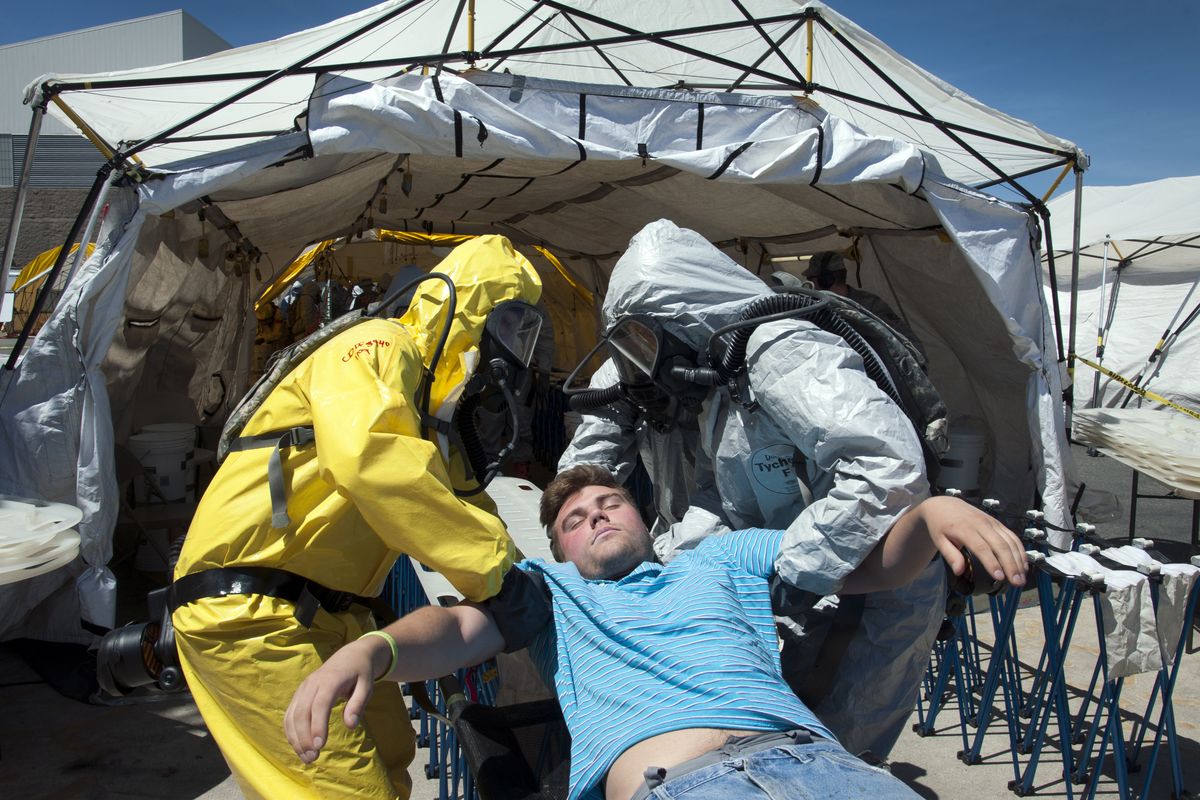Spokane hosts Homeland Response Force disaster training

A plane has just crashed in Spokane, and more than 500 military emergency responders are ready to help.
Around 9:30 a.m., they arrive on scene in buses and trucks. They set up power generators, communications equipment and water tanks and quickly erect a sprawling campsite that will serve as a base to decontaminate the area. In the distance, victims of the attack call out for help.
All the while, a clock is ticking, and observers ranging from military journalists to plainclothes civilians calmly watch from the sidelines.
The Spokane Fire Training Center played host on Wednesday to the third of five rounds of disaster-preparedness exercises for the Homeland Response Force, a unit fed by the Air Force and Army National Guard and tasked by the U.S. Department of Defense to respond within 6 to 12 hours to any chemical, biological, radiological, nuclear or explosive national disaster. Each day is a different disaster scenario, ranging from chemical attacks to building collapses to earthquakes.
Washington’s unit was one of the first established by the Defense Department. By the end of 2012, there were 10 nationwide to assist local first-responders.
Master Sgt. Chris Martin, a member of the 141st Air Refueling Wing, was one of many participating in the exercises who responded to the massive mudslide in Oso, Washington, in March that killed at least 42 people and engulfed several dozen homes.
Martin was part of the search and extraction team, which locates victims and brings them to the decontamination and medical triage tents. Although first responders were overwhelmed by the sheer size and scope of the Oso mudslide, he said, the regular exercises help prepare Guard members to handle a regional disaster.
“Oso really showed that,” Martin said. “When we got the call, our team was out the door in 24 hours … These exercises prepare us because they get us in a disaster mindset.”
About two hours after pulling into the compound, Guard members had set up camp, pulled on bulky aluminized decontamination suits and were extracting “victims” – paid local actors – from a small pile of rubble.
In a white trailer isolated from the action, make-up artists from IIF Data Solutions, a Virginia-based company that supports role-playing exercises, inflicted burns, bruising, blood loss and, in some cases, lodged glass and barbed wire on 105 victims.
The company contracts with the Guard to recruit and dress extras to participate in 15 such exercises a year, and keeps a binder of 400 distinct wounds with corresponding makeup instructions.
“Depending on what the scenario is, we’ll pick out the ones that we want,” IIF employee Peter Varljen said, leafing through the binder.
The goal is to mimic the profile of actual victims as closely as possible, and the exercise doesn’t end until all the actors are rescued, decontaminated and processed through medical tents, Guard spokesman Capt. Joseph Siemandel said.
Prior to decontamination, actors, who earned $15 an hour, bombarded the Guard with questions and, in some cases, physically struggle with them.
“Why do you need suits?” one woman asked. “What happened to us?”
“What are you doing just standing there?” another demanded. “Get that man a blanket!”
“You need to help her – she’s going into labor!”
“If you can hear my voice and you can walk, come my way!” one Guard member yells to the group.
The Homeland Response Forces consist of about 570 personnel – about 400 are command and control specialists, while 75 focus on decontamination, 50 on search and extraction and 45 on medical issues.
“It goes on skill set,” Siemandel said. “You’re talking about everything from communications, operations, logistics, stuff like that, to civil support. You got a little bit of everything here.”